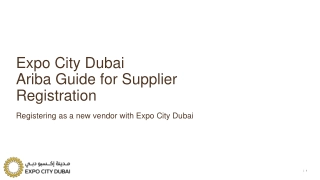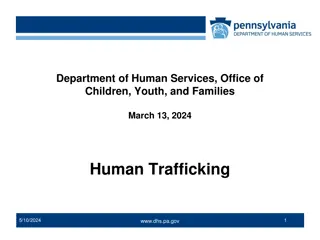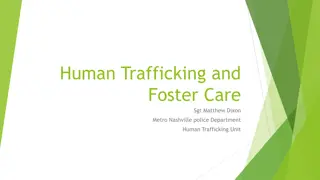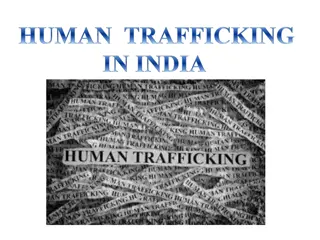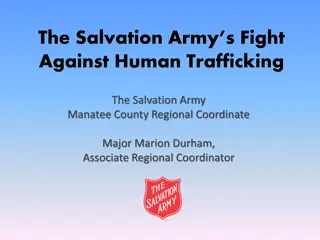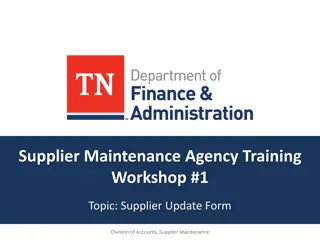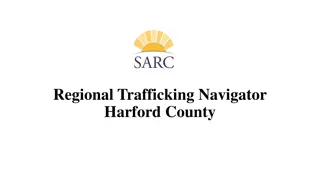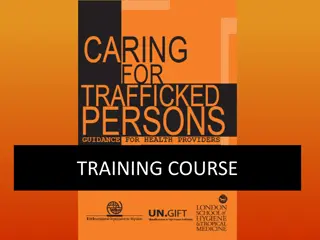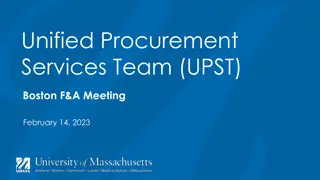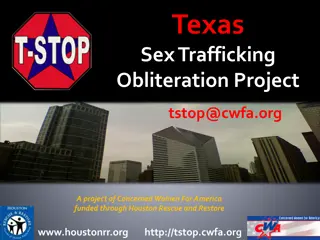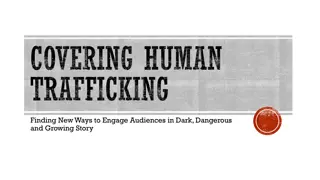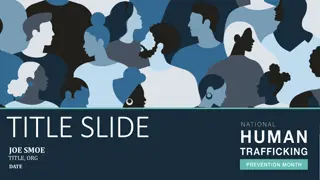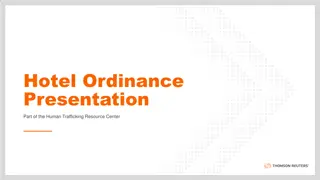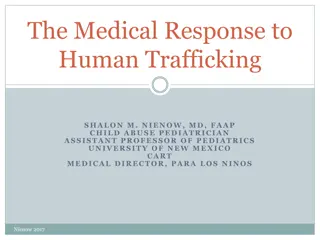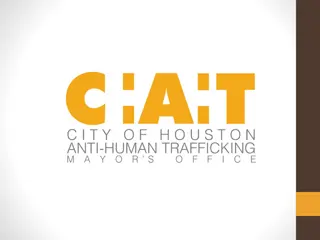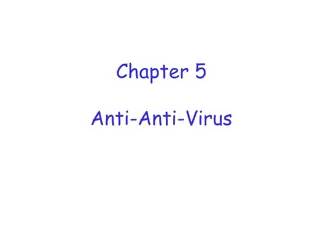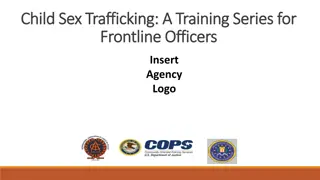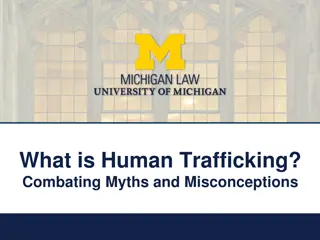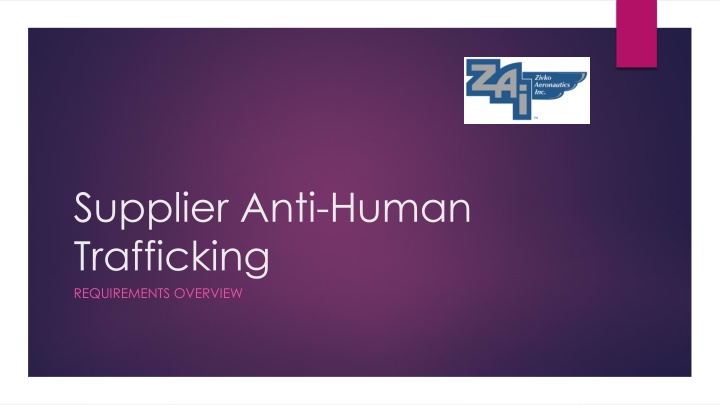
Supplier Anti-Human Trafficking Requirements Overview
Discover the comprehensive requirements and initiatives implemented by Zivko Aeronautics to combat human trafficking in the supply chain. Learn about FAR compliance, contractor/subcontractor obligations, and the elements of a robust compliance plan.
Download Presentation

Please find below an Image/Link to download the presentation.
The content on the website is provided AS IS for your information and personal use only. It may not be sold, licensed, or shared on other websites without obtaining consent from the author. If you encounter any issues during the download, it is possible that the publisher has removed the file from their server.
You are allowed to download the files provided on this website for personal or commercial use, subject to the condition that they are used lawfully. All files are the property of their respective owners.
The content on the website is provided AS IS for your information and personal use only. It may not be sold, licensed, or shared on other websites without obtaining consent from the author.
E N D
Presentation Transcript
Supplier Anti-Human Trafficking REQUIREMENTS OVERVIEW
Table of Contents Introduction FAR Requirements Zivko Aeronautics Approach Risk Factors Industry Information Due Diligence/Training Resources
Introduction As a responsible corporate citizen, ZAI fully supports the elimination of human trafficking and slavery from the supply chain. Our policies, practices and procedures reflect our strong commitment to human rights. Zivko Aeronautics, does not tolerate trafficking in persons, including the procurement of commercial sex acts, and the use of forced or child labor. We believe the transparent disclosure of our anti-human trafficking efforts is critical, and we report consistent with the requirements of current laws and regulations. We have implemented comprehensive policies and procedures, including our company Code of Business Conduct and Ethics, which requires our employees and suppliers to comply with applicable law and behave in an ethical manner. We believe our standards help to mitigate the risk of human trafficking in our supply chain. In addition, our standard procurement terms and conditions contain provisions requiring our suppliers to comply fully with all applicable laws and regulations, including explicit obligations regarding anti-human trafficking.
FAR Requirements FAR Contract Clause 52.222-50 Combating Trafficking in Persons Applies to all procurement actions Requires a compliance plan and annual certification (see conditions below) FAR Contract Clause 52.222-56 Certification Regarding Trafficking in Persons Compliance Plan Applies to all procurement action (prior to award and annually thereafter) Conditions: where a procurement, is for (i) supplies, other than commercially available off-the-shelf (COTS) items, to be acquired outside the United States, or services to be performed outside the United States; and (ii) has an estimated value that exceeds $550,000.
Contractor/Subcontractor Requirements The Contractor shall maintain a compliance plan during the performance of the contract that is appropriate (i) to the size and complexity of the contract; and (ii) to the nature and scope of the activities to be performed for the U.S. Government, including the number of non-United States citizens expected to be employed and the risk that the contract or subcontract will involve services or supplies susceptible to trafficking in persons. The obligations cover the entire supply chain and are not limited to the Contractor. As such, Contractors need to ensure that all of their supplies and their extended supply chain similarly comply with the contractual obligations.
FAR Compliance Plan Elements An awareness program to inform contractor employees about the Government s policy prohibiting trafficking related activities describe in paragraph (b) of FAR Clause 52.222-50, the activities prohibited, and the action that will be taken against the employee for violations. A process for employees to report, without fear of retaliation, activity inconsistent with the policy prohibiting trafficking in persons, including a means to make available to all employees the hotline plone number of the Global Human Trafficking Hotline at 1-844-888-FREE and its email address at help@befree.org. A recruitment and wage plan that only permits the use of recruitment companies with trained employees, prohibits charging recruitment fees to the employee, and ensures that wages meet applicable legal requirements or explains any variance.
FAR Compliance Plan Elements (cont) A housing plan, if the Contractor or subcontractor intends to provide or arrange housing, that ensures that the housing meets hose-country housing and safety standards. Procedures to prevent agents and subcontractors at any tier and at any dollar values from engaging in trafficking in persons (including activities in paragraph (b) of FAR Clause 52.222-50 and to monitor, detect, and terminate any agents, subcontracts, or subcontractor employees that have engaged in such activities. The Contractor shall post the relevant contents of the compliance plan, no later than the initiation of contract performance, at the workplace (unless the work is to be performed in the field or not in a fixed location) and ton the Contractor s Web site (if one is maintained) If posting at the workplace or on the Web site is impracticable, the Contractor shall provide the relevant contents of the compliance plan to each worker in writing.
Subcontractor Monitoring The prime contractor s monitoring efforts will vary based on The risk of trafficking in persons related to the particular product or service being acquired and whether the contractor has direct access to a work site or not. Where a prime contractor has direct access, the prime contractor would be expected to look for signs of trafficking in persons at the workplace, and if housing is provided, inspect the housing conditions. For cases where the employees and subcontracts are distant, or for laower tier subcontractors, the prime contractor must review the plans and certifications of its subcontractors to ensure they include adequate monitoring procedures, and to compare this information to public audits and other trafficking in persons data available.
ZAI Approach and Guidance ZAI s Code of Business Conduct and Ethics ZAI s Combating Trafficking in Persons Policy Supplier Profile/ZAI Annual Offeror Registration Data, Reps and Certs (Form 3001) ZAI Combating Trafficking in Persons Due Diligence Rep and Cert (Form 311A)
ZAIs Standard Terms and Conditions Anti-Trafficking in Persons clause Flow-down clause FAR 52.222-50 - Combating Trafficking in Persons Flow-down clause FAR 52.222-56 Certification Regarding Trafficking in Persons Compliance Plan (when applicable)
Global Supply Chain Due Diligence Level of Risk determined by performing an evaluation of Supplier Information and Scope of Work: Supplier responses to ZAI Form 1003, Reps and Certs Specific country where work will be performed Type of Work to be performed Duration of the work to be performed Almost all of ZAI s supplies and services are manufactured or performed in the United States.
Risk Factors Risks deriving from the Characteristics of the Product or Industry Low-skilled labor and Dirty, Dangerous, or Difficult work Seasonal or short product lifecycles Highly competitive industries with low barrier to entry Risks related to Business Processes Involved in Production and/or Supply of the Product Offshore manufacturing Reliance on labor recruiting Long, complex, or non-transparent supply chains Risks related to the Characteristics of the Workforce involved Poor, vulnerable, low-skilled workers Migrant workers
Risk Factors (cont) Political Risk Factors in the Country of Production Weak legal protection for civil liberties and workers rights Widespread corruption High level of crime and violence State persecution Political instability or conflict Socio-Economic Risk Factors in the Country of Production Level of national economic development High degree of gender inequality Use of Export Processing Zones (EPZs) (or Free Trade Zones/Industrial Free Zones)
Risk Factors (cont) Policy-Related Risk Factors in the Country of Production Immigration policies limiting the employment options or movement of migrants Lack of (or weak) bilateral agreements with migrant-sending countries Failure to ratify International Labor Organization (ILO) conventions related to human trafficking or rights or workers and migrants. Environmental Factors in the Country of Production Post-natural disaster
Industries with Significant Risk of Human Trafficking Agriculture Housekeeping/Facilities Operation Textile and Apparel Manufacturing Transportation and Warehousing Construction Electronics and Electrical Products Manufacturing Mining and Basic Metal Production Forestry Healthcare Hospitality Fishing and Aquaculture
Due Diligence Resources Responsible Sourcing Tool: https://www.responsiblesourcingtool.org/ Business & Human Resource Center: http://www.business- humanrights.org/en Corporate Register: http://www.corporateregister.com/ Ethical Trading Initiative: http://ethicaltrade.org/ Fair Labor Association: http://www.fairlabor.org/ Global Reporting Initiative: http://www.globalreporting.org/ Social Accountability International: https://www.sa-intl.org/
Training Resources State Department Human Trafficking Resources and Training https://www.state.gov/j/tip/ U.S. Department of Labor, Reducing Child Labor and Forced Labor Toolkit https://www.dol.gov/ilab/complychain/ U.S. Agency for International Development, Countering Trafficking in Persons https://www.usaid.gov/trafficking

